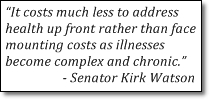Patricia Young Brown and TX State Senator Kirk Watson discuss new approaches to creating a healthier community over the next decade.
What’s growing even faster than the population of Central Texas? The need for—and cost of—health care, especially for underserved segments of our population. Two champions of innovative health care delivery discuss new models to shape the health and wellness of Central Texas in the coming decades.
Patricia Young Brown: The population of Central Texas is growing faster than the health care infrastructure needed to support a healthy and thriving region. The five counties in Central Texas—Bastrop, Caldwell, Hays, Travis and Williamson—are growing at 28 percent—a rate that is nearly four times the national average. Demographers predict that significant shifts in age distribution and racial and ethnic composition will alter the population’s health care needs, workforce composition and consumer tendencies. The concern is that populations with historically higher rates of chronic and preventable conditions will make up a larger portion of the population, further increasing the need for already strained healthcare services.
These shifts occur against a backdrop of health care costs that rose 138 percent between 1999 and 2010, while wages increased only 42 percent. Despite this increased spending, nearly 25 percent of residents lack health insurance, compared to 17 percent nationwide.
The course we are on is not sustainable—we do not have enough healthcare professionals to treat people who are sick and we do not have enough funding to pay for the growing demand for services. We need to make a significant shift in how we approach and consider the health care infrastructure and the health needs of our communities.
We can reverse these trends in Central Texas, but it demands collaborative organization and action across the community. The organizing committee supporting your "Ten Goals in Ten Years" represents a new collaboration that can advance the action we need.
 Senator Kirk Watson: This organizing committee has already realized tremendous advances by bringing together a unique network of entities that are committed to developing an entirely new model, not just of health care delivery, but also of medical education and preventive care.
Senator Kirk Watson: This organizing committee has already realized tremendous advances by bringing together a unique network of entities that are committed to developing an entirely new model, not just of health care delivery, but also of medical education and preventive care.
We are very fortunate here in Central Texas to have a robust health care infrastructure - from traditional health care providers to our hometown university's world-class research to Central Health's community-level care. My “Ten Goals in Ten Years” plan proposes building on these assets with a medical school, a teaching hospital, specialty care clinics, psychiatric care and more.
The key is that we cannot pursue these health care assets independently and separate them into silos. We have to get the different segments of the community out of their silos. What is so important about the "Ten-in-Ten Organizing Committee" is that it's a cross-sector network committed to developing an entirely new model, not just of health care delivery, but also of medical education and preventive care. This new model, a comprehensive system of care for our community, will raise the health of the entire region.
It’s about much, much more than a building with a sign on the side that says "Medical School." When I say medical education, I mean developing a community-wide approach that reaches people in their neighborhoods and in their homes.
PYB: That is the model Central Health has championed since its inception. Our goal is to develop Central Texas as a "Model Health Community" where we can propel sustainable health, quality of life and access to services for all citizens. We are organized around community clinics that partner with social service agencies as well as with more traditional medical providers. We are cultivating an approach toward preventive health and wellness management that improves quality of life for individuals where they live. And it’s working. Now we want to extend that vision to apply across the community.
KW: There is not a business model in the world that anyone would want to follow where you rely on the most inefficient way to conduct business. Unfortunately, health care is aligned to the most inefficient approach—waiting until someone is really sick and treating them at the most expensive health care entry point: the emergency room.
The approach Central Health is applying is much more efficient and makes a critical difference across the community. If people are managing their day-to-day care better, approaching wellness from an educated position with the resources they need to support wellness, they are not only happier and healthier, but they are showing up to work, they're able to take care of their kids and be active parts of a healthy community. And it costs much, much less to address health up front rather than face mounting costs as illnesses become complex and chronic.
For example, there is a cost to educate people with Type I diabetes about how to manage their health, monitor insulin or make healthy eating choices. But that cost is negligible when compared to what happens when a patient shows up in the emergency room requiring serious, acute care.
PYB: Unfortunately, the health care industry as a whole isn’t currently aligned to provide that level of preventive care. The things needed to support a vision of preventive care—community, in-home care providers, for example—are not necessarily reimbursable by health insurance or Medicare. So we have to find ways to change the incentives and adjust the culture to promote health and wellness as a community.
And we have to be prepared with an infrastructure that can help people stay healthy rather than just being available when they are sick. If we are going to support the move away from acute care to in-home care and in-community care that is accessible when it’s needed, we will need a health care workforce that can deliver that kind of care. Serving healthier people looks significantly different than serving sick people.
KW: That’s why it’s so exciting to be in Austin where we are as creative as it gets, right? We have an extraordinary opportunity to bring together all the industry sectors to align our infrastructure and invest in health and wellness. The organizing committee we’ve developed to support the Ten-in-Ten plan is the start; this diverse group of people are at the table figuring out how to build the right health infrastructure across the community.
PYB: That’s where we will be able to translate the practical shift—the acknowledgement that preventive care promotes sustainable health and wellness—into a cultural shift across the community. Health care providers talk to each other a lot—but it doesn’t do any good if health care providers are sitting in a room nodding our heads at each other but no one is incorporating these ideas into the way they go about their lives or businesses.
Central Health is now reaching out to the non-traditional entities who can adopt, benefit from and deliver healthy approaches. We are engaging those who might not be part of the conversation—the business community and people who may not be traditional users of the Central Health system—into conversations about how to shape a model healthy community.
We can already see employers implementing the shifts we’re talking about—recognizing that healthier employees are much better for their bottom lines than sick ones with lower rates of absenteeism, worker’s comp claims and healthcare costs. As we knit the rest of the community into this this conversation, we will begin to see that shift spread and lift the region as a whole. Not just health care—but health.
KW: And that healthier community is what will keep the Austin economic engine chugging along. At a very basic level, a new medical school and teaching hospital will draw more research, more clinical trials, and be a real economic driver for Austin. From an employment perspective, one study estimates that the Ten-in-Ten plan will create about 15,000 permanent jobs and about $2 billion in economic activity.
More importantly, in a new, knowledge-based economy, the economic asset is brain power. When people can connect from anywhere in the world, how do we make sure Austin is the place they want to live and work?
Central Texas has become an economic focal point in a world-wide economy because it’s a great place to live. We are creative, we are surrounded by great institutions of higher learning, we have a good quality of life with plentiful natural resources. If we want to continue cultivating that creative economic engine, we must carefully steward a quality of life that draws employers and attracts employees.
PYB: And that demands that we tap the creativity around us to knit together our assets into a health infrastructure that will support us into the next century. We’re on our way.










